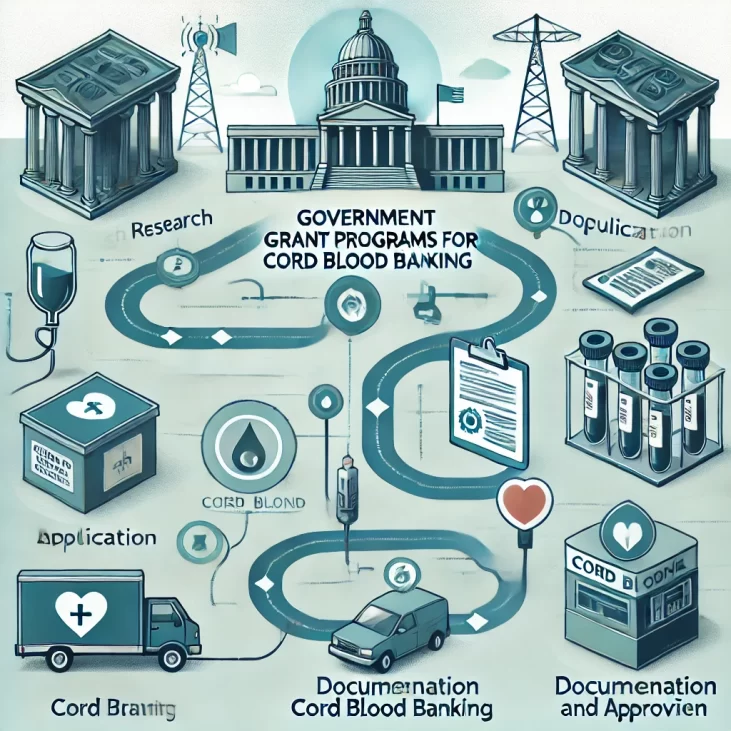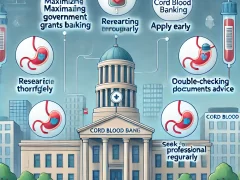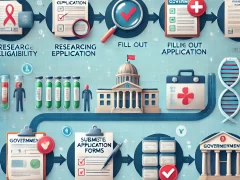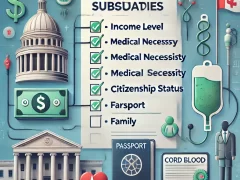
Cord blood banking has become an increasingly important aspect of modern healthcare, offering a valuable source of stem cells for various medical treatments. However, the financial burden associated with establishing and maintaining a cord blood bank can be a significant challenge. Fortunately, government grant programs can provide essential funding and support to help overcome these obstacles.
Tapping into Federal Grant Opportunities
The United States government, through agencies such as the National Institutes of Health (NIH) and the Health Resources and Services Administration (HRSA), offers a variety of grant programs designed to support the development and expansion of cord blood banking initiatives. These grants can cover a wide range of expenses, including infrastructure, research, and operational costs.
One of the key federal grant programs for cord blood banking is the Stem Cell Therapeutic and Research Act, which provides funding for the establishment and maintenance of the National Cord Blood Inventory (NCBI). This program aims to increase the availability of high-quality, ethnically diverse cord blood units for transplantation, making it a valuable resource for cord blood banks.
In addition to federal grant programs, many states also offer their own funding initiatives to support cord blood banking. These state-level grants can provide crucial financial assistance to local and regional cord blood banks, helping to address specific needs and challenges within their respective regions.
For example, the California Institute for Regenerative Medicine (CIRM) has a dedicated grant program for cord blood banking, which supports the collection, processing, and storage of cord blood units. Similarly, the New York State Department of Health has established the Umbilical Cord Blood Banking Program, offering grants to cord blood banks operating within the state.
Identifying and Applying for Grants
To successfully navigate the landscape of government grant programs for cord blood banking, it’s essential to have a well-structured and comprehensive grant application strategy. This includes thoroughly researching available grant opportunities, understanding the specific eligibility criteria and application requirements, and crafting a compelling proposal that highlights the potential impact and value of the cord blood banking initiative.
When preparing a grant application, it’s crucial to clearly articulate the objectives, methodology, and expected outcomes of the project. Additionally, demonstrating a strong track record of successful program management, financial stability, and collaboration with relevant stakeholders can significantly improve the chances of securing funding.
Leveraging Partnerships and Collaborations
Cord blood banking often requires the coordination of various stakeholders, including healthcare providers, research institutions, and community organizations. By fostering strategic partnerships and collaborations, cord blood banks can increase their chances of securing government grants by showcasing the breadth of their expertise and the potential for collaborative impact.
For instance, cord blood banks could explore partnerships with academic medical centers or research laboratories to demonstrate their commitment to advancing scientific research and clinical applications. Similarly, collaborations with patient advocacy groups or community health organizations can highlight the potential for the cord blood banking program to address the needs of underserved populations.
Navigating the complex landscape of government grant programs for cord blood banking can be a daunting task, but the potential rewards are significant. By diligently researching available funding opportunities, crafting compelling grant proposals, and leveraging strategic partnerships, cord blood banks can access the resources they need to expand their reach, enhance their services, and ultimately improve patient outcomes. With a dedicated and well-planned approach, cord blood banking initiatives can secure the necessary financial support to thrive and contribute to the advancement of regenerative medicine.
The Importance of Cord Blood Banking in Healthcare
Cord blood banking has become a crucial aspect of modern healthcare, offering a wealth of potential benefits for individuals and society as a whole. As the field continues to evolve, understanding the various government grant programs available can be a game-changer for those interested in cord blood banking.
Cord blood is the blood that remains in the umbilical cord and placenta after a baby is born. This valuable resource is rich in stem cells, which can be used to treat a variety of medical conditions, from blood disorders to certain types of cancer. By banking cord blood, families can preserve this potential lifesaving resource for future use.
Exploring the Benefits of Cord Blood Banking
Cord blood banking offers a range of benefits that make it an increasingly popular choice for expectant parents. One of the most significant advantages is the potential to use the stored stem cells for future medical treatments. These stem cells can be used to replace damaged or diseased cells, potentially leading to improved outcomes for the child or even other family members.
Furthermore, cord blood banking can provide a valuable source of genetic material for research and development, contributing to advancements in regenerative medicine and personalized healthcare. As the field of stem cell therapy continues to evolve, the importance of cord blood banking becomes even more pronounced.
Understanding Government Grant Programs
To make cord blood banking more accessible, various government grant programs have been established to support families in this endeavor. These programs provide financial assistance, helping to offset the costs associated with cord blood collection, processing, and storage.
One such initiative is the Stem Cell Therapeutic and Research Act, which was signed into law in the United States in 2005. This act authorizes funding for the National Cord Blood Inventory, a program that aims to increase the availability of cord blood units for transplantation. Families can explore eligibility requirements and application processes to potentially receive financial support for their cord blood banking efforts.
Applying for government grant programs can be a complex process, but with the right guidance, families can navigate the landscape with confidence. Many cord blood banking providers offer assistance in identifying and applying for relevant grant opportunities, streamlining the process for their clients.
It’s important to note that the specific requirements and eligibility criteria for these grant programs can vary by location and funding source. Families should thoroughly research their options, gather the necessary documentation, and be prepared to submit a comprehensive application that highlights the potential impact of their cord blood banking efforts.
Maximizing the Impact of Cord Blood Banking
By taking advantage of government grant programs, families can not only make cord blood banking more affordable but also contribute to the larger ecosystem of stem cell research and therapeutic development. When more individuals participate in cord blood banking, the pool of available genetic material grows, enhancing the potential for medical breakthroughs and personalized treatments.
Moreover, increased accessibility to cord blood banking can lead to greater awareness and education among the general public, empowering more people to make informed decisions about this valuable resource. This, in turn, can drive further advancements in the field and improve healthcare outcomes for generations to come.
Navigating the world of cord blood banking can be a complex endeavor, but with the support of government grant programs, families can overcome the financial barriers and unlock the incredible potential of this life-saving resource. By understanding the benefits, exploring the available grant options, and navigating the application process, individuals can play a vital role in shaping the future of healthcare and contributing to the advancement of stem cell research and personalized medicine.
Maximizing Financial Assistance for Cord Blood Storage
Cord blood banking is a valuable healthcare service that can provide families with a potential lifeline in the future. However, the costs associated with storing and maintaining cord blood can be a significant barrier for many individuals. Fortunately, there are government grant programs available that can help alleviate the financial burden of cord blood banking.
Identifying Eligible Grant Programs
The first step in accessing government grant funding for cord blood banking is to identify the relevant programs. These programs can vary depending on the country, state, or region, so it’s essential to research the options available in your specific location. Some common examples include:
- National Cord Blood Program (NCBP) in the United States
- Cord Blood Bank Grants in Canada
- Cord Blood Stem Cell Funding Schemes in the United Kingdom
Understanding Eligibility Criteria
Each government grant program will have its own set of eligibility criteria, so it’s crucial to review the requirements carefully. Factors that may be considered include household income, medical history, and the intended use of the cord blood. It’s important to note that some programs may have specific income thresholds or other restrictions, so it’s essential to thoroughly understand the criteria before applying.
Once you’ve identified the relevant grant programs, the next step is to navigate the application process. This may involve submitting detailed financial information, medical records, and other supporting documentation. It’s important to carefully review the application requirements and ensure that all necessary information is provided to increase the chances of a successful application.
Maximizing Your Chances of Approval
To increase your chances of being approved for a government grant, it’s important to prepare a comprehensive and well-organized application. This may involve seeking assistance from a professional grant writer or consulting with a financial advisor who specializes in healthcare-related funding. Additionally, it’s important to be mindful of application deadlines and to submit your materials in a timely manner.
Ongoing Maintenance and Reporting
If your application is approved, you’ll need to maintain compliance with the grant program’s requirements. This may involve submitting regular reports on the use of the funds, providing updates on the status of the cord blood storage, and adhering to any other program-specific guidelines. Failure to comply with these requirements could result in the loss of funding or other penalties, so it’s essential to remain diligent in your record-keeping and reporting.
Leveraging Multiple Funding Sources
In addition to government grant programs, there may be other sources of funding available to help offset the costs of cord blood banking. This could include private insurance coverage, employer-sponsored benefits, or charitable organizations that provide financial assistance. By exploring multiple funding options, you can maximize your chances of securing the financial resources needed to ensure the long-term storage and maintenance of your child’s cord blood.
Navigating the world of government grant programs for cord blood banking can be a complex and challenging process. However, by understanding the eligibility criteria, preparing a comprehensive application, and leveraging multiple funding sources, families can access the financial assistance they need to ensure the long-term viability of this valuable healthcare resource.
Leveraging Governmental Initiatives for Cord Blood Preservation
Unlocking Funding Opportunities for Cord Blood Banking
In the realm of medical advancements, the preservation of cord blood has become a crucial aspect of modern healthcare. Cord blood, rich in stem cells, offers invaluable potential for treating a wide range of medical conditions, from blood disorders to regenerative therapies. As the demand for cord blood banking services grows, individuals and organizations alike are seeking ways to tap into governmental initiatives and funding opportunities to support their efforts.
Navigating the complex web of governmental grant programs can be a daunting task, but with the right approach, organizations can unlock the funding they need to establish or expand their cord blood banking operations. One such initiative is the Stem Cell Therapeutic and Research Act, which provides federal funding to support the collection and preservation of cord blood, as well as the development of new therapies.
Leveraging the Stem Cell Therapeutic and Research Act
The Stem Cell Therapeutic and Research Act, initially passed in 2005 and subsequently reauthorized, has been instrumental in driving advancements in cord blood banking and stem cell research. This legislative initiative has allocated millions of dollars in funding to support the National Cord Blood Inventory (NCBI), a network of public cord blood banks that collect, process, and store cord blood units for public use.
Exploring State-Level Funding Opportunities
In addition to federal-level initiatives, many states have also recognized the importance of cord blood banking and have implemented their own funding programs to support local efforts. These state-level initiatives often provide grants and tax incentives to encourage the establishment of cord blood banks, as well as to support research and educational efforts.
Securing governmental funding for cord blood banking can be a complex process, but with the right approach, organizations can increase their chances of success. This typically involves thoroughly understanding the eligibility requirements, crafting a compelling proposal that aligns with the funding agency’s priorities, and effectively communicating the potential impact of the project.
Leveraging Partnerships and Collaborations
To further enhance their chances of securing governmental funding, cord blood banking organizations can also explore opportunities for partnerships and collaborations. By joining forces with academic institutions, research centers, or other healthcare providers, they can present a more comprehensive and compelling proposal that showcases the broader benefits of their work.
Staying Informed and Adaptable
The landscape of governmental funding for cord blood banking is constantly evolving, and organizations must remain vigilant in staying informed about the latest developments and funding opportunities. This may involve regularly monitoring government websites, subscribing to relevant mailing lists, and networking with industry peers to stay ahead of the curve.
The preservation of cord blood is a vital component of modern healthcare, and governmental funding initiatives can play a crucial role in supporting the growth and development of this essential field. By navigating the complex grant landscape, leveraging existing programs, and fostering strategic partnerships, cord blood banking organizations can unlock the resources they need to drive innovation, enhance patient care, and ultimately improve the lives of countless individuals.
Unlocking the Potential of Cord Blood Through Public Funding
Cord blood banking has emerged as a significant medical advancement, offering potential benefits for both individuals and public health. However, the financial burden of cord blood banking can be a significant barrier for many families. Fortunately, there are various government grant programs available to help alleviate the costs and make this valuable resource more accessible.
Uncovering Public Funding Opportunities
Navigating the complex landscape of government grant programs can be daunting, but it’s essential to understand the available options. Many states and federal agencies offer financial assistance to families interested in cord blood banking. These programs often cover a portion of the initial collection and storage fees, making the process more affordable.
Eligibility Criteria and Application Process
To access these government grants, it’s crucial to understand the specific eligibility criteria and application process. Factors such as income level, health insurance coverage, and geographic location may all play a role in determining eligibility. Additionally, the application process can vary, with some programs requiring detailed financial information and others focusing more on medical history.
Donating cord blood to a public bank is another option that can provide financial relief for families. Public cord blood banks are often supported by government funding, which allows them to offer the collection and storage services at a reduced cost or even free of charge. However, the donation process can be intricate, and it’s essential to work closely with healthcare providers to ensure a smooth and compliant experience.
Maximizing the Potential of Cord Blood
Government grants and public cord blood banking not only provide financial assistance but also play a crucial role in expanding the availability and accessibility of this valuable resource. By supporting cord blood banking, these programs contribute to the growth of a diverse and representative donor pool, increasing the likelihood of successful matches for those in need of transplants.
Overcoming Barriers and Advocating for Change
Despite the availability of government funding, many families still face significant barriers in accessing cord blood banking services. This can be due to a lack of awareness, bureaucratic hurdles, or disparities in healthcare accessibility. By advocating for increased funding, streamlined application processes, and broader public education, we can work to overcome these challenges and ensure that all families have the opportunity to preserve their child’s cord blood.
Embracing the Future of Cord Blood Medicine
As the field of regenerative medicine continues to evolve, the potential applications of cord blood are becoming increasingly diverse. From the treatment of hematological disorders to the development of novel therapies for conditions like autism and cerebral palsy, cord blood holds the promise of transformative medical breakthroughs. By leveraging government support and encouraging further research, we can unlock the full potential of this remarkable resource and improve health outcomes for generations to come.
Navigating the world of government grant programs for cord blood banking requires diligence and perseverance. But the rewards can be substantial, both for individual families and for the broader public health landscape. By understanding the available funding options, familiarizing ourselves with the application process, and advocating for greater access, we can empower more families to preserve this invaluable biological resource and contribute to the advancement of cord blood-based therapies.
Conclusion
Navigating the complex landscape of government grant programs for cord blood banking can unlock significant financial support and opportunities for both individuals and organizations invested in this vital healthcare sector. By understanding the importance of cord blood banking, maximizing available financial assistance, and leveraging governmental initiatives, stakeholders can bolster their efforts to preserve this invaluable resource.
Cord blood, the blood that remains in the umbilical cord and placenta after childbirth, is a rich source of hematopoietic stem cells, which have immense therapeutic potential. These stem cells can be used to treat a wide range of conditions, from blood disorders and immune deficiencies to certain types of cancer. The preservation of cord blood through banking has become an increasingly crucial aspect of modern healthcare, offering patients and healthcare providers access to a readily available source of stem cells for potential future treatments.
Government grant programs play a pivotal role in supporting the growth and accessibility of cord blood banking. These initiatives provide financial assistance to individuals, hospitals, and cord blood banks, enabling them to offset the costs associated with the collection, processing, and long-term storage of cord blood samples. By tapping into these funding sources, families can make cord blood banking more affordable, while healthcare providers and cord blood banks can enhance their capabilities and expand their services.
Leveraging governmental programs and policies can significantly impact the advancement of cord blood preservation. Public funding initiatives, such as those aimed at increasing public awareness, supporting research and development, or subsidizing storage fees, can help overcome the financial barriers that have historically hindered the widespread adoption of cord blood banking. When these governmental efforts are combined with proactive outreach and education, the potential of cord blood can be more effectively unlocked, benefiting both individual patients and the broader healthcare system.
The integration of cord blood banking into mainstream healthcare has been a gradual process, but the increasing recognition of its clinical value has paved the way for greater public and private investment. Government grant programs have emerged as a crucial catalyst in this journey, providing the necessary financial resources to drive innovation, enhance accessibility, and ultimately improve patient outcomes.
By navigating the complexities of government grant programs, stakeholders in the cord blood banking industry can secure the funding needed to expand their capabilities, enhance public awareness, and contribute to the advancement of regenerative medicine. This strategic approach not only benefits individual families but also strengthens the healthcare infrastructure and positions cord blood as a valuable asset in the fight against a wide range of medical conditions.
The intersection of government grant programs and cord blood banking presents a significant opportunity for healthcare providers, researchers, and individuals to amplify the impact of this vital healthcare resource. By leveraging these financial incentives and aligning with governmental initiatives, the potential of cord blood can be fully realized, transforming the landscape of modern medicine and improving the lives of countless individuals.



















